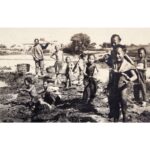Photography Chinese Woman and Manchu Woman
A black-and-white photograph, studio portrait of two women. The woman on the left is Han Chinese and the woman on the right is Manchu. They are sitting at a table with a cup of tea. A potted chrysanthemum is on the floor in front of the table.
A Manchu woman can be recognised by her erbatou 二把頭 hairstyle, which consists of two figs attached to each side of her head. It is reinforced with an additional wire frame and extensions, and adorned with various decorations – from flowers to jewellery. The traditional Manchu garment changpao 長袍, the predecessor of the more familiar qipao 旗袍, was intended for formal occasions. The Manchu woman is also wearing a silk breast jacket with the characteristic protective collar Huling 護領. The garment is made of sophisticated embroidery with finely embroidered floral patterns. Particularly striking are the chrysanthemums, which are also found on a typical hairstyle. The Chinese woman on the left is wearing a padded garment with ... more
A black-and-white photograph, studio portrait of two women. The woman on the left is Han Chinese and the woman on the right is Manchu. They are sitting at a table with a cup of tea. A potted chrysanthemum is on the floor in front of the table.
A Manchu woman can be recognised by her erbatou 二把頭 hairstyle, which consists of two figs attached to each side of her head. It is reinforced with an additional wire frame and extensions, and adorned with various decorations – from flowers to jewellery. The traditional Manchu garment changpao 長袍, the predecessor of the more familiar qipao 旗袍, was intended for formal occasions. The Manchu woman is also wearing a silk breast jacket with the characteristic protective collar Huling 護領. The garment is made of sophisticated embroidery with finely embroidered floral patterns. Particularly striking are the chrysanthemums, which are also found on a typical hairstyle. The Chinese woman on the left is wearing a padded garment with pants and a longer jacket. The clothing is dark, with no decorative embroidery or other accessories, except for a few white buttons on the jacket and scarf. They are wearing lotus shoes, lianlü 蓮履, a kind of conical shoe worn by women with bandaged feet. They are sewn from silk or bamboo and are the same size as the palm of a hand. Some had a heel or a thickened sole.
Portrait photography became the most popular genre in China after photography “conquered” the country. After only a few years, photography supplanted portraiture wherever Westerners were present, and later spread to other places. The reason is simple: portraiture was an important tradition in both China and the West even before photography.
The photograph was taken in the same studio as the photograph “Manchu Woman in Winter Clothing” with the same model and scene. It also appears in other photo collections.
The photograph is the 161st of 449 photographs of Beijing and its surroundings in the album of Ivan Skušek Jr., purchased during his stay in Beijing (1914–1920). In the handwritten inventory of the album, the photograph is referred to as Chinesin und Mandschufrau. (DZ, MV)





































Do you have a comment or additional information about the subject?